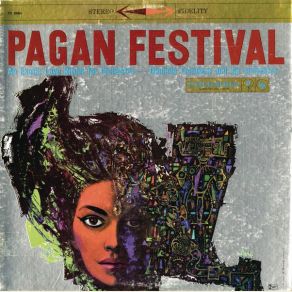Pagan Festival: An Exotic Love Ritual for Orchestra
Download links and information about Pagan Festival: An Exotic Love Ritual for Orchestra by Dominic Frontiere. This album was released in 1959 and it belongs to Jazz, Pop, Instrumental, Smooth Jazz genres. It contains 12 tracks with total duration of 33:57 minutes.

|
|
|---|---|
| Artist: | Dominic Frontiere |
| Release date: | 1959 |
| Genre: | Jazz, Pop, Instrumental, Smooth Jazz |
| Tracks: | 12 |
| Duration: | 33:57 |
| Buy it NOW at: | |
| Buy on iTunes $9.99 | |
Tracks
[Edit]| No. | Title | Length |
|---|---|---|
| 1. | Festival | 4:06 |
| 2. | House of Dawn (Paccari-Tampu) | 2:16 |
| 3. | Temple of Suicide (Ixtab) | 2:57 |
| 4. | Moon Goddess (Ixchel) | 2:42 |
| 5. | Time of Sunshine (Yaxkin) | 2:40 |
| 6. | Goddess of Love (X-Tabai) | 3:01 |
| 7. | House of Pleasure (Tampu-Anca) | 2:38 |
| 8. | The Harvest (Zax) | 2:23 |
| 9. | Corn Festival (Zabacil Than) | 2:15 |
| 10. | God of Seasons (Kuklkan) | 3:12 |
| 11. | Jaguar God (Balam) | 3:11 |
| 12. | Venus Girl (Ix-Koben) | 2:36 |
Details
[Edit]After recording four albums for the small, independent Los Angeles label Liberty Records, Hollywood arranger/composer Dominic Frontiere got work from the major labels in 1959, organizing the Mighty Accordion Band, which released the LP They Said It Couldn't Be Done on Capitol, and signing on with Columbia Records to make Pagan Festival: An Exotic Love Ritual for Orchestra. Arthur Lyman had recently scored a substantial hit with Taboo, and Martin Denny was preparing his chart-topping Exotica, ironically for Liberty; Pagan Festival was conceived in the same exotic style. The liner notes spoke of the music's "interpretation of ancient Inca rituals, superstitions, and the romance and mysteries of their colorful civilization," but the blending of musical styles was not limited to that of the ancient Latin American culture (if anyone even knew what that would sound like). Frontiere let his imagination run wild, and he brought in sounds from the South Pacific to Eastern Europe. From his work in the movie studios as well as his formal training, he had a broad knowledge of musical styles and a willingness to mix and match to achieve desired effects, without regard to musical purity. So, here a female choir wafted in and out along with string sections, brasses, and reeds, creating a patchwork quilt that somehow held together. Of course, somewhere in there, Frontiere also found use for his own chosen instrument, the accordion. Did the Incas play accordions while performing their pagan rituals? Perhaps not. But Frontiere's music charmed like a particularly entertaining Hollywood score for a movie set in some faraway place, but shot on a backlot. It may not have been historically accurate, but it was a lot of fun to listen to.